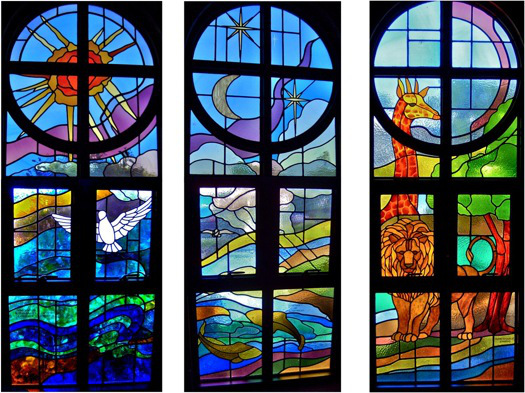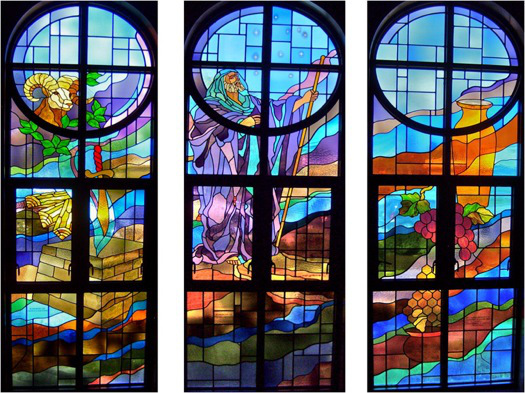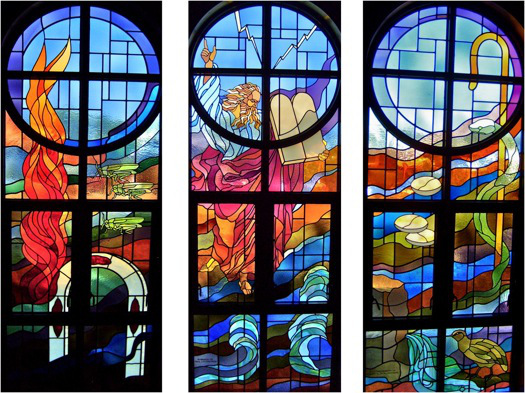Introduction
Most families possess objects of sentimental value: pictures, mementos of special occasions, birth certificates, marriage certificates, genealogies, etc. These objects perpetuate the people and values that are loved and esteemed by the family. They help the family members to remember and identify who they are, where they came from, and how they got to where they are.
The windows of our church serve a similar purpose. They help us to remember those who have gone before us and modeled the ideals to which we are called by our faith. They also recall how God entered into human history in order to save us.
Most importantly, they remind us that through the new covenant established by Jesus Christ, we all have a relationship with God, and through him, with one another. Covenants (or Testaments) are solemn oaths between persons by which they become family or kin. The Church’s term for covenant is sacrament. Therefore we enter into this covenant relationship with God and his family at Baptism. We renew this covenant every time we offer the sacrifice of the Mass.
So with a sense of family we ask you to consider the following explanation of our church windows.
Creation (cry room)
This set of windows recalls the great event of creation. While there are two creation stories in the Bible (Genesis 1-2:4a, Gen. 2:4b-24) these windows recall only the first such story.
The first window depicts dark raging water over which the Spirit of God is stirring in the form of a dove. The sun is used as a symbol for light, which was the initial creation.
The second window shows a moon and stars as well as a bird, a fish and a stream, which symbolize the events of days 2, 4 and 5. Chaotic waters, now made orderly and separated into water and air, are filled with living things appropriate to them.
The third window has plants and animals. It speaks to the creation of all lands and the living things that fill them, as occurred on Days 3 and 6. Man who is made in God’s image, while not symbolized, is definitely implicit throughout this event of creation, for it is Man who has the responsibility to direct and care for Creation.
Abraham triplet (faith)
The set of windows reflects upon the faith modeled by Abraham, who lived about 1850 B.C. Why Abraham? He is an ancestor of Jesus (Mt 1:1), and when God called him, he believed, left everything, and was justified. (Gen 15:6) Furthermore, when his faith was
tested, he remained obedient and continued to be justified by God throughout his life. (Jas 2:21-22, Rom 4:19-22)
The first window shows a ram, an altar, firewood and a sword. These symbols recall Abraham’s supreme act of faith, his willingness to sacrifice his only son in obedience to God. (Gen 22) This took place on Mt. Maraiah, where 800 years later King Solomon would build the temple in Jerusalem. This is the same mountain where Jesus, the only Son of God, would be offered up on the cross.
The second window shows Abraham with a staff and sky of stars. This depicts Abraham’s call and recalls the threefold promise that God made to him: descendants, a promised land, and blessings for all the families of the earth. (Gen 12:1-3) The stars remind us of God’s promise to Abraham that he would have more descendants than the stars of the sky or the sand of the seashore. (Gen 15:5) The staff symbolizes Abraham’s leadership and authority and God’s protection.
The third window shows a milk jar, a vine and grapes, and a honeycomb with a crock pot. This window depicts the promised land, the “land flowing with milk and honey.” (Ex 3:8)
Moses Triplet (old covenant)
The third triplet of windows concerns Moses. He lived about 1250 B.C. and is mentioned about 80 times in the New Testament, more than any other Old Testament person. The events surrounding his life are the central events of the Old Testament (or old covenant). These include the passover meal, the exodus from Egypt, and the covenant at Mt. Sinai. Moses’ faith manifested itself in leadership by service and was tested by God throughout his life.
The first window depicts a pillar of fire, locusts, and doorposts sprinkled with blood. The locusts represent the ten plagues that God visited on the Egyptians (Ex 7-12). The blood recalls the passover meal, established as a remembrance of God delivering the Isrealites from 400 years of slavery. (Ex 12) The pillar of fire represents God’s providence and guidance. During the exodus and the 40 year in the desert, the Isrealites were led by a pillar of cloud by day and a pillar of fire by night. (Ex 13:17-21, Num 9:15-23) It foreshadows the tongues of fire that descended upon God’s people at Pentecost.
The bolts of lightning in the second window recall the appearance of God to Moses on Mt. Sinai. Below them stands Moses with two stone tablets representing the 10 commandments, which indicate the conditional nature of the old covenant. The waves represent the parting of the Red Sea.
The third window shows manna, quail, water flowing from a rock and a staff with a serpent on it. During their 40 years in the desert the Israelites experienced a food and water shortage as well as a plague of venomous snakes. Through these daily trials God tested their faith. Moses’ steadfast faith and obedience was rewarded through the gift of manna and quail and water from a rock. (Ex 16, 17; Num 11, 20) The staff represents
God’s healing power; when those bitten by snakes looked on this image, God healed them. (Num 21) At the end of the 40 years in the desert, the Isrealites, now great in number, entered the promised land. Only the third part of the promise to Abraham was left unfulfilled.
Jesus triplet (New Covenant)
The fourth triplet of windows symbolizes the Paschal Mystery (the life, death, resurrection and ascension of Jesus). This is the center of the new covenant (or New Testament). Jesus is the final fulfillment of the promises to Abraham—blessings for all nations. He is the new Lawgiver (Dt 18:15-18) These windows will focus on the most important events in the life of Jesus.
The first window remembers various events in Christ’s life. The shell and flowing water represent Jesus’ baptism and reception of the Holy Spirit. (Mt 3:13-17) The caduceus signifies his healing ministry, his power over sin and illness. (Is 35:5, Lk 7:22) The scroll reflects Jesus as the fulfillment of the Old Testament prophecies. The bread and cup are reminiscent of the feeding of the multitudes and the Eucharist, which parallels the Passover Meal. As the Passover recalls the old covenant established on Mt. Sinai, the Eucharist renews the covenant formed at Calvary.
In the second window we see Christ’s Passion and death. The crown of thorns recalls the royal ancestry of Jesus as a descendant of King David and the suffering of Christ. The cross rising out of a tree symbolizes his sacrificial death. (Dt 1:23, Gal 3:13) The Lamb with blood and water flowing from its side recalls John 19:33-37 where Christ’s side was pierced with a spear. The water symbolizes the giving of the Holy Spirit (Jn. 7:38-39) and the blood, his Sacrifice.
The third window reflects on the Resurrection, Ascension and second coming of our Lord. The empty tomb is a clear reference to the resurrection. (Mt 28, Mk 16, Lk 24, Jn 20) The rays from above recall God’s approval of his Son’s sacrifice. The charcoal fire with the fish depicts Jesus’ third appearance to his disciples on the shores of Galilee after his resurrection. Finally, the cloud represents Christ’s ascension (Acts 1:6-11) and his coming at the end of time. (Lk 21:27, Rev 1:7, I Thess 4:17)
Church triplet (the new church)
The last triplet of windows deals with the Church, the New people of God. We are the ultimate fulfillment and beneficiary of the promise to Abraham. We are the
numerous descendants. We have been brought to the promised kingdom. We receive the blessings of God and transmit them to the rest of humankind.
In the first window, we see how we are saved and made members of God’s family.The cross recalls Jesus’ sacrifice, the source of our salvation. The tongues of fire symbolize Pentecost, when the Holy Spirit descended on the initial members of Christ’s church in visible form (Acts 2:1-13). The Church passes on the gifts of the Spirit to its children by
means of the sacraments (particularly Baptism, Confirmation and Eucharist). The 7-branched candlestick represents the 7 sacraments. Sin is the chain that has been broken (Acts 2:38).
The second window is concerned with the authority and leadership of the church. St. Peter, holding keys and a book, stands next to a rock. This image signifies Jesus’ words, “Thou art Peter and upon this rock I will build my Church” (Mt 16:18). Peter was given the authority to lead the Church. The keys are an ancient symbol of authority to rule (Is 22:15-25, Mt 18:18, Lk 22:31-32, Jn 21: 15-17) while the book shows his authority to teach and interpret revelation (I Peter 1:20-21). It also represents Scripture. The combination of Peter and the book signifies the Church’s balance of sacred Scripture, Apostolic tradition, and the teaching authority of the Church.
The third window depicts the Church’s mission to “Go into all the world and proclaim the Good News” (Mk 16:15-16). The ship is an ancient Christian symbol for the church. The net and fish recall Christ’s parable about his kingdom. (Mt 13:47-50) The hen and chicks refer to the solicitude and concern expressed by Jesus about Jerusalem: “How often have I desired to gather your children together as a hen gathers its brood under her wings.” (Mt 13:47-50, Lk 13:34) The golden gate symbolizes our ultimate goal and perfection to be realized in Heaven (Rev 21:10-21)
Conclusion
Just as faith was necessary for Abraham to enter into relationship with God, so it is necessary for us. The formalization of our relationship with God is achieved in Baptism. We enter into the family of God begun by Abraham and continued by the Church. So it is appropriate that the Abraham and church triplets flank the baptistry area of the church.
Moses led the People of God when they entered into the Old Covenant. Jesus leads us into the New Covenant by his actions at the Last Supper. This new covenant (foretold in Jer 31:31-37) is renewed upon our altar, where the sacrifice of Christ is commemorated and made present again. Therefore, these triplets flank the altar.
The pillar of fire in the Moses triplet (God’s leadership) mirrors the tongues of flame in the church triplet (the inspiration of the first Christians). There are other relationships between windows. You can discover these relationships by reading Scripture. It is the fondest hope of our Parish family that these windows lead you to the Scriptures, and that the Scriptures lead you to God and His family.



